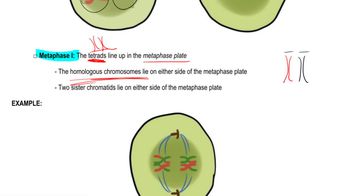Examine the following diagrams of cells from an organism with diploid number 2n=6, and identify what stage of M phase is represented.
Our closest primate relative, the chimpanzee, has a diploid number of 2n =48. For each of the following stages of M phase, identify the number of chromosomes present in each cell.
end of mitotic telophase
 Verified step by step guidance
Verified step by step guidance
Verified video answer for a similar problem:
Key Concepts
Diploid Number

M Phase of Cell Cycle

Mitotic Telophase

Homocystinuria is a rare autosomal recessive condition on the RUSP list of conditions screened by newborn genetic testing. The condition results from a mutation that blocks the degradation of the amino acid methionine. The absence of a critical enzyme causes the buildup of the compound homocysteine, which is one of the intermediate compounds in the methionine breakdown pathway. Homocystinuria causes mental impairment, heart problems, seizures, eye abnormalities, and a number of other symptoms that shorten life if not treated. The condition is treated by a specialized diet that is low in methionine and by the ingestion of several supplements.
Why do you think eating a low-methionine diet is critical to controlling homocystinuria?
Homocystinuria is a rare autosomal recessive condition on the RUSP list of conditions screened by newborn genetic testing. The condition results from a mutation that blocks the degradation of the amino acid methionine. The absence of a critical enzyme causes the buildup of the compound homocysteine, which is one of the intermediate compounds in the methionine breakdown pathway. Homocystinuria causes mental impairment, heart problems, seizures, eye abnormalities, and a number of other symptoms that shorten life if not treated. The condition is treated by a specialized diet that is low in methionine and by the ingestion of several supplements.
The low-methionine diet must be maintained throughout life to manage homocystinuria. Why do you think this is the case?
Our closest primate relative, the chimpanzee, has a diploid number of 2n =48. For each of the following stages of M phase, identify the number of chromosomes present in each cell.
meiotic metaphase I
Our closest primate relative, the chimpanzee, has a diploid number of 2n =48. For each of the following stages of M phase, identify the number of chromosomes present in each cell.
end of meiotic anaphase II
Our closest primate relative, the chimpanzee, has a diploid number of 2n =48. For each of the following stages of M phase, identify the number of chromosomes present in each cell.
early mitotic prophase
